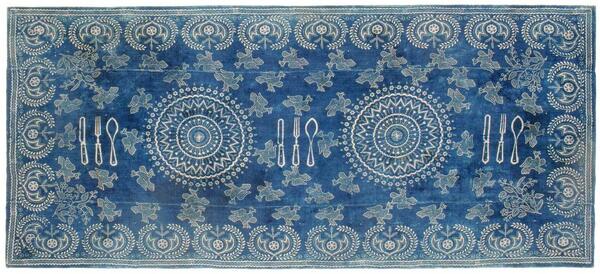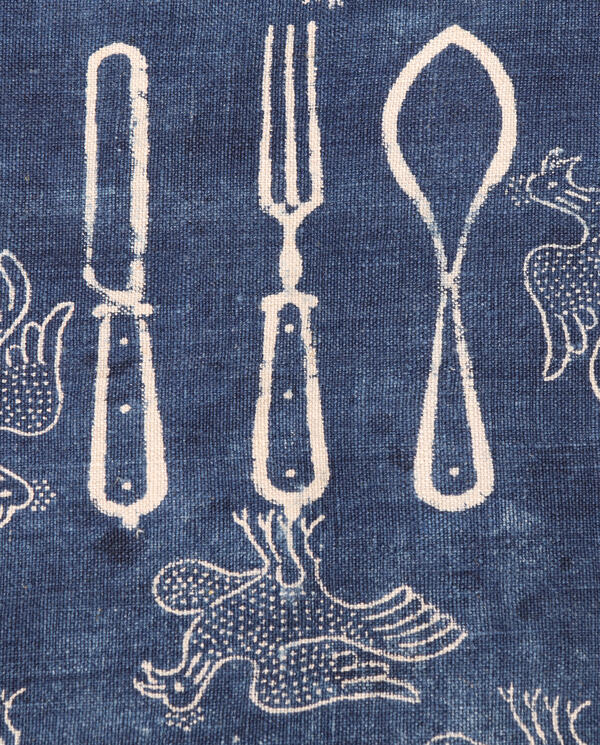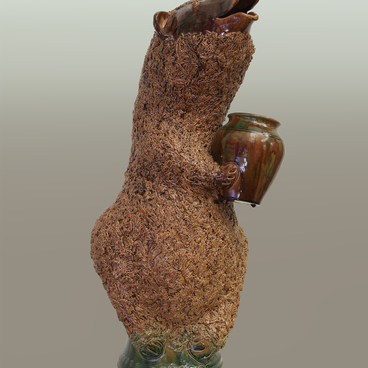Russian cube blue tablecloths are exceptionally interesting pieces of folk art. The term “cube woodblock printing” derived from the peculiarities of the manufacturing process: the fabric was dyed in a cauldron that was called a “cube”. The cube contained a mixture of indigo, iron sulphate and quicklime. The artisans kept the recipes of the dye secret and passed them down from generation to generation. The indigo dye was imported from southern countries where the indigo plant was grown. It was famous for its durability. Both men’s and women’s clothes were made from patterned cloths.
For peasants, a tablecloth was an attribute of a festive ritual. It was used during agricultural and religious rites and meals.
A blue tablecloth is so full of symbols that it can be “read”. Images of birds are associated with Christian holidays and poetic images of folk wedding songs. The border of the tablecloth is formed by ears of wheat — they are depicted in such a way as to form the silhouette of a fruit. This symbol of abundance came to Russia along with oriental fabrics. The wavy lines represent the rain necessary for farming.
The collection of the Russian Museum has 18 blue printed tablecloths from different regions of the country. The uniform compositional solutions and the symbolism of the patterns display the features inherent in all Russian folk art: the combination of practical use with deep and generalized content. The original meaning of the tablecloth as a ritual object was preserved by Russian woodblock printers of the 19th and even the 20th century in traditional patterns, acquiring everyday features.
The tablecloth from the Pskov Governorate is noteworthy since the artisan’s name and his nickname associated with the profession of a dyer have been preserved. In this fabric of the early 20th century, the ancient symbolism was combined with a “tavern” plot: solar rosettes in the center became plates with cutlery depicted on the sides.
Even in the 20th century, the peasant dye-printing craft in Russia retained the old forms of organization. It was closely connected with the manual production of linen canvas and employed established methods of printing. In the 1930s, after the socialization of peasant farms and the nationalization of industry, the craft ceased to exist.
For peasants, a tablecloth was an attribute of a festive ritual. It was used during agricultural and religious rites and meals.
A blue tablecloth is so full of symbols that it can be “read”. Images of birds are associated with Christian holidays and poetic images of folk wedding songs. The border of the tablecloth is formed by ears of wheat — they are depicted in such a way as to form the silhouette of a fruit. This symbol of abundance came to Russia along with oriental fabrics. The wavy lines represent the rain necessary for farming.
The collection of the Russian Museum has 18 blue printed tablecloths from different regions of the country. The uniform compositional solutions and the symbolism of the patterns display the features inherent in all Russian folk art: the combination of practical use with deep and generalized content. The original meaning of the tablecloth as a ritual object was preserved by Russian woodblock printers of the 19th and even the 20th century in traditional patterns, acquiring everyday features.
The tablecloth from the Pskov Governorate is noteworthy since the artisan’s name and his nickname associated with the profession of a dyer have been preserved. In this fabric of the early 20th century, the ancient symbolism was combined with a “tavern” plot: solar rosettes in the center became plates with cutlery depicted on the sides.
Even in the 20th century, the peasant dye-printing craft in Russia retained the old forms of organization. It was closely connected with the manual production of linen canvas and employed established methods of printing. In the 1930s, after the socialization of peasant farms and the nationalization of industry, the craft ceased to exist.






